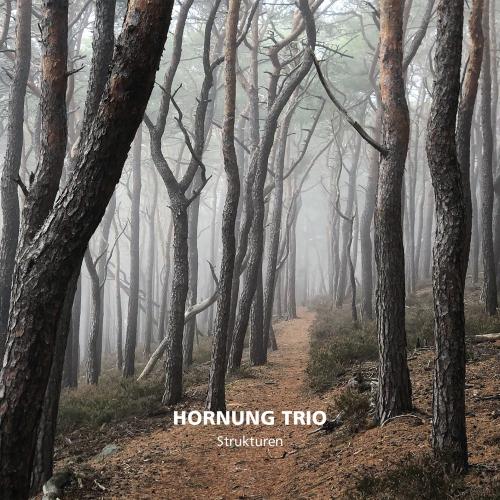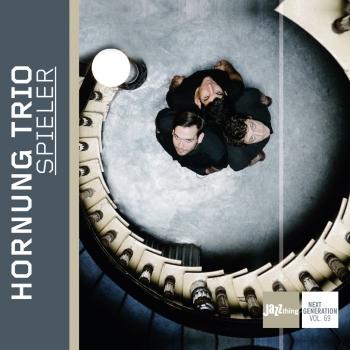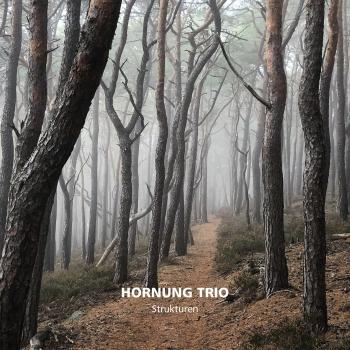
Strukturen Hornung Trio
Album info
Album-Release:
2022
HRA-Release:
23.09.2022
Album including Album cover
- 1 Strukturen 04:42
- 2 Wenn die Sirenen wieder rufen 09:26
- 3 Schizzo 07:59
- 4 Nikolai 05:52
- 5 Im Rausch 07:57
- 6 Mach 06:10
- 7 Leer 05:19
Info for Strukturen
Perhaps the most noticeable difference between American and European jazz pianists is that those from the “old world” generally grow up with classical music before devoting themselves to improvised music. It is of course no coincidence that influences from (late) Romanticism to Classical Modernism can also be heard - now more strikingly than ever - in Ludwig Hornung’s playing. They give his compositions and his dynamic improvisations a distinctively individual character. Moreover, they reflect a striking development of the musician and his band, whose debut Spieler [Player] was released in 2017 on Double Moon Records.
The impressive palette of timbres that becomes possible solely through a finely nuanced touch on the grand piano, is essential for all pieces on Strukturen [Structures]. As is the abandonment of traditional forms, such as the typical ‘theme-solo-theme’ sequence. “It was important to me to avoid any rigid parameters,” Ludwig Hornung states, “and already while composing, the subtle tonal qualities of classical music inspired me a lot.” He is no less enthusiastic about “the way Scriabin or Messiaen handled chords and harmonies, which was revolutionary at the time.” While exploring music of the early 20th century, Hornung came across a Russian composer whose works had (and have) a direct and lasting influence on him: Nikolai Roslavets. “His pieces are on the edge to atonality, I perceive him as a link between Scriabin and Schoenberg. What fascinates me about Roslavets is how he unites the typical Russian power, gloom and emotional heaviness with the peaceful moods and delicate detail of French Impressionism.”
The album’s title piece “Strukturen” evokes associations with other classical composers, its glittering arpeggios for instance hint at Chopin and Liszt. On the other hand, Hornung’s captivating improvisation makes it clear that he is, above all, a passionate jazz player. As such, he particularly admires Paul Bley, the “quiet genius of free jazz” (Melody Maker) who died in 2016. In addition, since his youth Hornung has had a liking for - attention, sharp turn - hip-hop. “I’m particularly interested in these ‘wobbly’ beats, which I first heard from J Dilla, but which are also very present in the music of Flying Lotus for example,” Hornung explains. “Like when the snare hits a little too late or the kick drum comes a touch too early. That makes even simple rhythms seem kind of unusual, they get something draggy or asymmetrical.”
Hornung uses this principle of suspenseful irregularities in the closing piece “Leer” [Empty], which prompts Oezsevim to play slightly displaced beats. In other compositions Hornung plays with odd meters: the sometimes flowing, then again jagged “Schizzo” and “Mach” are based on 7/4 and 5/4 time signatures. In contrast, in the calmer “Nikolai” and the solemn “Wenn die Sirenen wieder rufen” [When the Sirens Call Again] he completely leaves out any rhythmic beat to make space for atmospheric, free drum parts. A mixture of both approaches can be heard in “Im Rausch” [Inebriated], which initially avoids any concrete rhythmic pattern, but then moves through different time signatures in the solo sections.
The balance, or one could also say the seamless alternation between notated and improvised passages, as well as the potential for energetic, exhilarating build-ups, are also characteristic creative means of the agile trio, that was founded in 2016. Only in the title piece did Hornung clearly notate even the drum groove; besides that, he gives the intuitive drummer Bernd Oezsevim a lot of freedom in how he shapes the pieces with independent, sometimes complex parts. Hornung’s collaboration with the versatile bassist Phil Donkin dates back to the year 2011. “I really appreciate both of them for their energy as well as their ability to accompany modestly at times,” the bandleader observes. “Phil is excellent at building on ideas and forming foundations; he’s extremely adept rhythmically and provides strong impulses. Furthermore, he and Bernd work perfectly together - even when there are longer breaks sometimes, because everyone is also in demand for other engagements.”
How well the trio’s musicians harmonize with one another can be seen from the fact that all tracks were recorded in the studio after just three rehearsals. “We actually managed to record some of the pieces in the first take, while we spent quite some time working on other tracks,” Hornung describes the concentrated and creative atmosphere of the recording sessions.
Born in Bad Dürkheim in 1986 and raised near the German Wine Route, Ludwig Hornung began taking piano lessons at the age of six. At eighteen, he won a CD recording at Bauer Studios with Vapour Trail, his band at the time. After two years at the University of Music in Stuttgart, Hornung transferred to the Jazz Institute Berlin, where he graduated with a bachelor’s degree with top marks; the jazz studies there also include classical music lessons. Parallel to his acoustic trio, Hornung formed a second band, Triebwerk Hornung, in which he focused on the Fender Rhodes alongside saxophonist Wanja Slavin, backed by John Schröder on drums, who was later replaced by Oliver Steidle. Before the pandemic, Hornung was also part of an album by Tobias Meinhart, and subsequently toured Central and Southern Europe and Ecuador with Meinhart’s band, including guest star Kurt Rosenwinkel. For some months now, Hornung has also been performing solo programs in which he mixes jazz and classical repertoire.
Hornung hints at an important but not yet mentioned aspect of Strukturen in a few sentences on the cover. The intensity of the music, he says, also stems from having put a lot of “dirt off his soul“ into the writing process. “The time was relatively complicated. The music reflects the tension between pain and euphoria that I was experiencing at the time, which I was ultimately able to transform into a positive energy,” Hornung says. “In the end, part of dealing with strong emotions was the question of how I was going to create structures for my future life.“
The new album of the Ludwig Hornung Trio is a real surprise, at least for those who have not seen the band live recently. Intricate compositions and excited improvisations, the incisive use of timbre and dynamics, and the unique sources of inspiration make Strukturen stand out far in the colorful field of piano jazz. Determined stylistic intent, captivating intensity and a lively joy in their playing ensure long-lasting and repeated listening pleasure.
Ludwig Hornung, piano
Phil Donkin, doublebass
Bernd Oezsevim, drums
Ludwig Hornung
Der Pianist komponiert und arrangiert für sein eigenes Quartett (Modern Jazz, CD "Pour La Chambre d'Aga" bei Intuition und CD "Sur Le Fil" bei Unit Records erschienen) und spielte mit seinem Quartett CD-Release-Konzerte in ganz Europa, unter anderem in London, Paris, Lyon, Lissabon, Berlin, Kassel, Swinemünde. Er begleitet andere musikalische Projekte wie Mi Solar (kubanische, Weltmusik), Enrico & Groove (Latin Jazz), Terra Caliente (Latin, Fusion ), Bérangère Palix & Band (französische Chansons), und weitere. Er war Mitglied der Band "Mo' Blow" (früher "Sahnefunk", Tour in London, Liverpool, Paris, Brüssel, Antwerpen, Norddeutschland, Dresden). Thibault Falk spielte unter anderem mit Kenny Martin, Michael Clifton, Fuasi Abdul-Khaliq, Ray Blue, Carlos Bica, Michael Kersting. In den Jahren 2007 und 2008 hielt er sich für musikalische Engagements in Dubai und Lausanne auf. Seitdem ist er in Berlin und widmet sich wieder seiner eigenen Musik.
This album contains no booklet.









